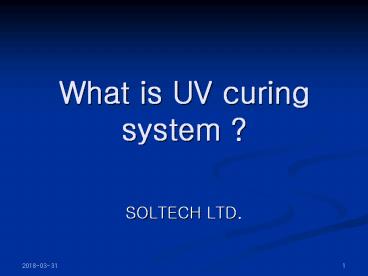What is UV curing system ? - PowerPoint PPT Presentation
Title:
What is UV curing system ?
Description:
What is UV curing system ? SOLTECH LTD ... polymer network UV * * Oligomer Epoxy acrylate Urethane acrylate Polyester ... coating Non-silicone leveling agent ... – PowerPoint PPT presentation
Number of Views:1768
Avg rating:3.0/5.0
Title: What is UV curing system ?
1
What is UV curing system ?
- SOLTECH LTD.
2
Advantages
- Energy saving
- No volatile solvent
- Very short cure time
- No heat
- One pack system
- Space saving
3
UV(200400nm) curing
UV
- Photo-initiator P. (free radicals)
- Free radical monomer oligomer
- Cross linked polymer network
4
Oligomer
- Epoxy acrylate
- Urethane acrylate
- Polyester acrylate
- Acrylic acrylate
- Amino acrylate
5
Epoxy acrylate (1)
Chemical resistance , fast cure and hardness
- Paper coating
- Overprint varnish
- Wood coating
- Ink application (screen , offset)
- Solder resist ink
6
Epoxy acrylate (2)
- BPA epoxy acrylate (Solmer E 120,145,146,1686)
- Paper and wood
coating - Acrylate of epoxydized oil (Solmer E 186)
- ink application
- Modified epoxy acrylate (Solmer E
1701,1702,1703..) - screen ink ,
paper and wood - Novolac epoxy acrylate (Solmer E
1626,1636,1656..) - solder resist ,
hard coating - Acid modified Epoxy Acrylate (Solmer E 1695)
- PSR , metal
coating
7
Urethane Acrylate (1)
- Toughness , flexibility , adhesion and
non-yellowing - Plastic and film coating
- Floor tile coating
- Screen ink
- PVC floor and wood coating
- Adhesive
- Anti-fog coating
8
Urethane Acrylate (2)
- Polyester type (Solmer U 584, 594, 580)
- adhesion , toughness
- Polyether type (Solmer U 530, 564)
- flexibility , fast cure
- Others (Solmer U 522, 522B, 520, 5260)
- fast cure , hardness
9
Polyester Acrylate
- Adhesion , pigment-wetting , low viscosity
- Offset and screen ink
- Solmer P 236
- Etching resist
- Solmer P 270,271,272
- Paper and Wood coating
- Solmer P 280,281
- Flexo ink
- Solmer P 280,281
- Laminating adhesive
- Solmer P 220
10
Acrylic acrylate
- Adhesion , solvent resist , non-yellowing
- Plastic coating
- Overprint varnish
- Adhesive
- Solmer A 345,364,3710
11
Amino acrylate
- Improve UV cure response
- Paper and Wood coating
- Screen ink
- Solmer Z 115, 225
12
Additive
- Silicone Acrylate (Solmer Z 9135, 9136)
- slip and substrate wetting
- Adhesion promoter (Solmer Z 9166, 9167)
- PCB ink , metal and plastic
coating - Non-silicone leveling agent (Solmer Z 9070)
- screen ink
13
Monomer (1)
- How to select monomer?
- Viscosity and Solubility
- Volatility
- Odor and toxic property
- Reactivity and functionality
- Percent of shrinkage
14
Monomer (2)
- Mono NVP, Styrene, IBXA, PEA
- Di TPGDA, HDDA, TTEGDA
- Tri TMPTA, PETA
- Others PE4A, DPHA
15
Monomer (3)
- A viscosity, reactivity, hardness, gloss,
chemical resistance - B flexibility, solvency, adhesion
16
Strategy for formulation
- 1. Select Oligomer(s) for basic film forming
properties - 2. Use Monomer for viscosity control
- 3. additives for performance fine tuning
- 4. photo-initiator package is critical
17
General principles
- 1.Each component plays a key role in total
performance - Formulate for total performance
- Optimize on performance requirements
- Viscosity control, simple dilution no!
18
General principles
- 2. formulations are sensitive to curing process
parameters and equipment - Use controls in experimental design to see
effects of external factors
19
General principles
- 3. cost/performance is the key
- Raw material costs
- Volume dependency
- Energy costs
- Labor costs
- Competitive pricing
20
Oligomers
- Basic film forming properties
- Hardness abrasion
resistance - Chemical resistance scratch resistance
- Flexibility adhesion
- Toughness weatherability
21
Oligomers
- Other considerations
- Cure speed stability
- Cost toxicity
- Special properties availability
22
Monomers
- Viscosity reduction
- Flexibility (monofunctional)
- Crosslinking (multifunctional)
- May also increase speed
23
Additves
- Wetting pigment
- Flow filler
- Slip temperature
- resistance
- adhesion
24
Photo-initiator
- Cost type of system
- Pigment/color processing variables
- Film thickness
25
Application
- Wood , paper board coating
- Plastic (PVC floor, ABS, PC,PP)
- Adhesive (laminating, PSA)
- Ink (screen, wet dry offset, flexo)































